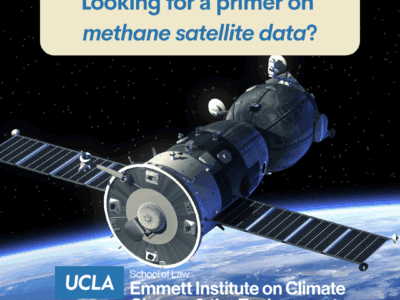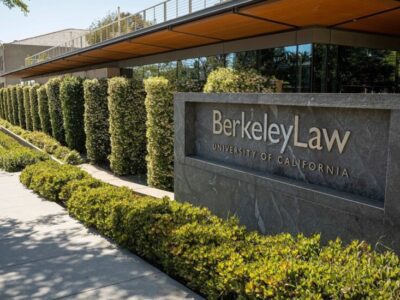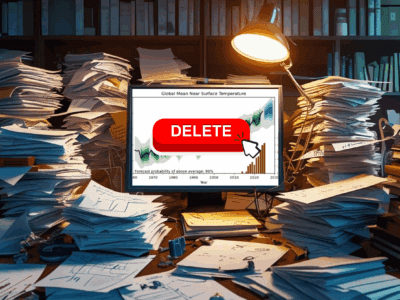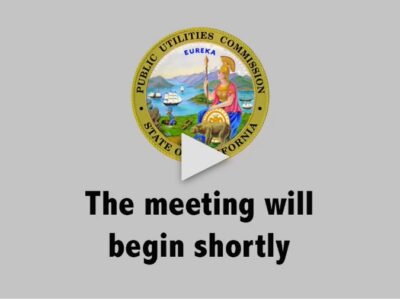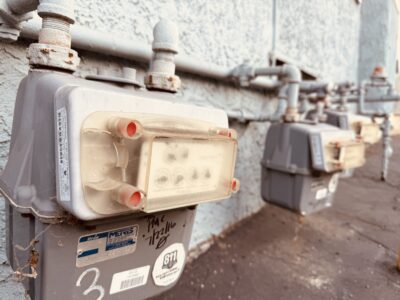How Methane Satellites Work and Why it Matters
This new UCLA Law report aims to help policymakers understand the science and utility of methane satellites.
These days, I'll take progress on climate change where I can get it. And one place to look right now is up -- literally. New satellites are providing never-before-seen data about global methane sources, helping policymakers, industry, and others target that superpollutant in new ways. Today, some colleagues at UCLA Law and I are releasing a new report aimed at helping policymakers understand these new tools, along with their uses and limits. With this report...
CONTINUE READINGDear 2025 1L:
It’s no secret that this is a dark time for people who care about the environment. The Trump Administration and the Republican Congress have converged on the goal of boosting fossil fuels. Their solution to the environmental harms caused by these fuels is to deny the seriousness of climate change, weaken air pollution regulations, and upend protections for ecosystems and endangered species. In short, we are digging ourselves deeper into a hole. Although these are ...
CONTINUE READINGThe Energy Secretary Pushes Pseudoscience
The Drain is a weekly roundup of environmental and climate news from Legal Planet.
Remember alternative facts? That catch phrase from Season 1, Episode 1 where Trump officials lied about the size of his inauguration crowd has now metastasized into a governing philosophy for how federal agencies plan to ignore, and ultimately exacerbate, the climate crisis. Trump 2.0 is pushing alternative science. Late last month, Energy Secretary Chris Wright and the Energy Department rushed a report called "Critical Review of Impacts of Greenhouse Gas Emission...
CONTINUE READING“Hi, Can you Hear Me?” A CPUC Debrief
The California Public Utilities Commission heard an earful about neighborhood decarbonization. Here's the input from Californians who support climate action.
More people who want climate action should attend public forums like the ones that the California Public Utilities Commission held last Thursday regarding the selection of neighborhood decarbonization projects. More of us should sit on these calls and sign up to speak. Even if we aren’t party to a specific proceeding or don’t feel expert enough. Or don’t want to dedicate one hour of our lives to hearing fellow callers struggle with the mute button and then wast...
CONTINUE READINGEmergency Powers Aren’t What They Used to Be
In the post-WW2 era, courts bent over backwards to accomodate emergency actions. Not true today, as Trump is finding out.
In mid-century America, emergency powers were truly potent. But those days are gone. In his two terms as President, Trump has declared 21 national emergencies, including eight since January 20. This glut of "emergencies" can only further discredit the whole concept. He and his advisors seem to see those as creating nearly magical legal powers, allowing them to deport people without hearings, run roughshod over environmental safeguards, and impose tariffs willy-nilly. The...
CONTINUE READINGTime for a Positive Vision of America’s Environment
Restore and Respect America the Beautiful
With the Trump Administration attacks on climate science, renewable energy, research, power plan emissions standards, EVs, national monuments, and pretty much anything that smacks of environmental protection, it is not surprising that most responses from the environmental community and the Democratic party have been to defend the status quo. The defensive posture has resulted in a perceived lack of vision or alternative. With that in mind, here’s a pretty straight...
CONTINUE READINGMayor NIMBY
Karen Bass' blocking of duplexes in devastated communities is a nasty piece of plutocracy.
Los Angeles Mayor Karen Bass gets a lot of unfair grief from the media and from Angelenos. Many criticized her for being out of the country when the Palisades Fire struck: but she was abroad in Africa representing President Biden (when in Congress one of her areas of expertise was Africa), and mayors do this sort of thing all the time. Now attorneys are suing the City for alleging not having enough water in municipal reservoirs during the fire, although shortages did not...
CONTINUE READINGFrom Sacramento to Geneva: Two Arenas Tackle Plastic Pollution
California considers adding microplastics to its Candidate Chemical List as delegates negotiate a Global Binding Treaty on Plastics in Switzerland
Last Monday, the California Department of Toxic Substances Control (DTSC) closed its public comment period on a proposal to add microplastics to its Candidate Chemicals List. Adding microplastics to this list would allow the State’s Safer Consumer Product Program to evaluate potential Priority Products that may contain or release microplastics. The Program works to make products safer for people and the environment by identifying and promoting products that use saf...
CONTINUE READINGGas Utilities Can Do Better on Neighborhood Electrification
The state’s largest gas utilities are trying to delay priority zones for decarbonization and to block public access to important data. The CPUC should push them to do more.
Last fall, I wrote about the promise of SB 1221, a law that created a pathway for the California Public Utilities Commission (CPUC) to approve pilot projects that will support priority “neighborhood decarbonization zones” to transition away from building gas service toward zero-emissions alternatives, including electrification and thermal energy networks. Now, the gas utilities have submitted their initial system maps and priority neighborhood proposals for CPUC ...
CONTINUE READINGHow Trump’s War on Research Hurts the US Economy
The economic evidence confirms the huge benefits of government support for research.
The Trump Administration has gone to war against science. Trump's budget calls for cutting federal research funding almost in half. Billions of dollars in research grants to universities have been cancelled. The Administration is also gutting research across the government, from the Environmental Protection Agency to the National Institutes of Health. But the Administration has given little thought about how this will harm competitiveness in a high-tech world. Rig...
CONTINUE READING



